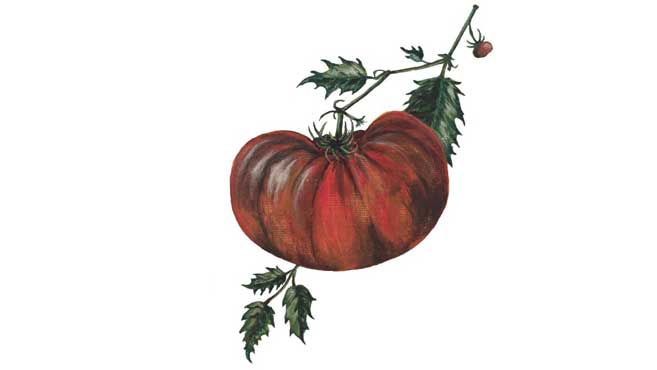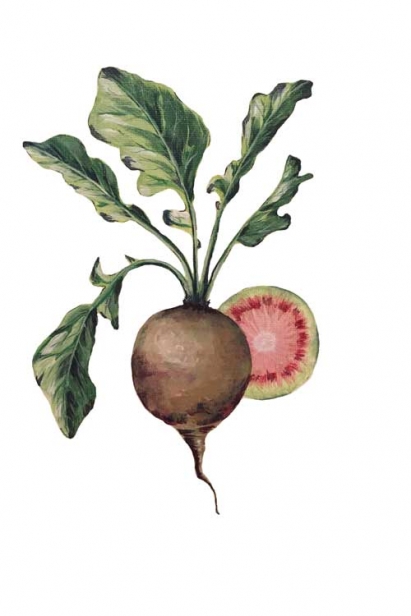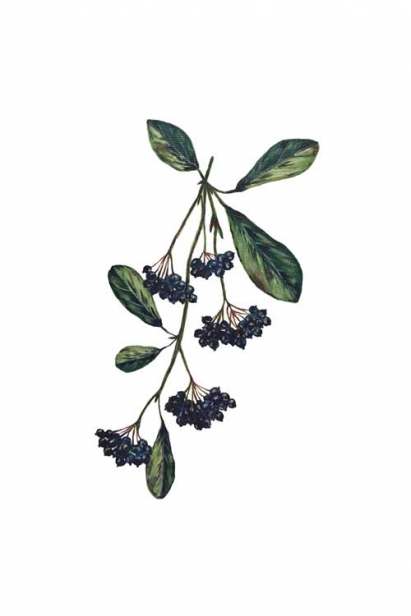Produce That Pops
3 New Varieties to Seek Out This Summer
Ninety-seven. Incredibly, that’s the number of small farms listed in the Farm Fresh Atlas of Southeastern Wisconsin. How fortunate we are in this corner of the state to have such an abundance of fresh veggies, fruits, herbs, poultry, pork, meats, honey, nuts, bakery and mushrooms! That number doesn’t even include our dairy farms.
Not long ago, I remember it used to be that you could find fresh produce and prepared goods at a farmers’ market only on Saturdays. The farmers’ market business has boomed in the last few years as more chefs and home cooks insist on buying and whipping up fresh and regional. So now Monday–Sunday, you can find a market to visit, taste-test delicious stuff, and stock up for the week on the goodness of locally grown.
From Whitewater to West Bend, Fox Point to Lake Geneva, Horicon to Janesville, Thiensville to Bristol, there are plenty of tantalizing opportunities to rest your eyes on sparkling colors and surprising shapes, and smell the freshness of things which grew in the dirt or on a tree just hours ago.
Newer in produce bins are three unique ingredients making more of an appearance in markets and on menus, as farmers and chefs branch out to less familiar crops. Keeping customers surprised and educated in their gastronomic adventures is definitely a trend in the field, as well as the restaurant kitchen.
Heirloom Tomatoes
Although not new by definition, we are seeing more and more of the beautiful varieties of heirlooms. (3,000+ varieties of heritage tomatoes are actively cultivated around the world, and thousands more are in existence.) According to tomato experts Craig LeHoullier (a North Carolina chemist) and Carolyn Male (a New York microbiologist), heirlooms fall into four categories:
- Commercial Heirlooms: Open-pollinated varieties introduced before 1940, or tomato varieties more than 50 years in circulation.
- Family Heirlooms: Seeds that have been passed down for several generations through a family.
- Created Heirlooms: Crossing two known parents (either two heirlooms or an heirloom and a hybrid) and dehybridizing the resulting seeds for how ever many years/generations it takes to eliminate undesirable characteristics and stabilize desired characteristics.
- Mystery Heirlooms: Varieties that are a product of natural cross-pollination of other heirloom varieties.
What makes heirloom tomatoes so special? “Beauty … they are gorgeous! We eat with our eyes, you know!” says Michelle Cannon of LarryVille Gardens in Burlington. “I grow green tomatoes, red, pink, purple, black, gold; I have grown white ones, too. Then there is size and shape. Some are heartshaped, pear-shaped, round, cherry, and the big buxom, almost-too-big-to-hold-itself-up! Belly buttons, cracking, catfacing—all words to describe the heirlooms’ imperfections. The uglier, the better flavor, we like to say.”
But it’s a combination of taste and looks, of course, that puts heirlooms heads above many of the basic varieties you’ll find commercially grown and stocking the produce aisles of grocery stores. “The taste is to die for!” Cannon says. “Flavor needs to be intense, sweet, or balanced, or full; the flavor needs to hold you in its wonderful grasp just a bit and urge you to the next bite.”
They have such intriguing luscious names, too. Cannon says she grows “Black Cherry, Prudens Purple, Paul Robeson, Japanese Black Trifele, Italian Red Pear and Italian Heirloom, Gold Medal, German Pink, Green Giant, my own Hungarian Italian, and new this year, a yellow cherry.”
Not surprisingly, there is science behind the more succulent taste of heirlooms, as researchers have found out. Using 152 heritage tomato varieties to taste-test with the standard supermarket tomatoes, scientists found that chemicals called volatile compounds are the driver of the heirlooms’ more pure, intense scent and flavor with the very first bite. A particular volatile compound, geranial, turned out to be the real magic behind the makeup of the heirlooms tested. Researchers believe geranial brings out the inherent sweetness of the heritage varieties.
We compromise on flavor and texture when we purchase the common flawless, perfectly-shaped commercial tomatoes at our local grocers. Those impeccable, and no doubt tantalizing, red orbs are bred for high yield and stability during their transport from farm to supermarket. Yes, the plants are able to produce abundant fruit, but simultaneously the sugar content suffers. And the taste of tomatoes depends on a balance of the sugars and acids in the fruit. This summer, look for heirlooms at your local farmers’ market starting in late July.
Watermelon Radish
I’ve never been a huge radish fan … I’m just going to admit that! But that was until I tried the watermelon radishes that so beautifully decorated the salads I’ve ordered in the past year. They are called watermelon radishes due to their appearance—a light greenishwhite exterior with a bright cerise center that when sliced, looks very much like a piece of miniature watermelon. Typically larger than the red-globe radishes, they can weigh up to a pound.
Also known as Roseheart or Red Meat radish, the crunchy watermelon radish is an heirloom Chinese daikon radish. In China, it’s known as shinrimei [pronounced “shin-rimay”], which means “Beauty-In-TheHeart.”
A watermelon radish tastes on the spicy side when it’s small, but sweet and crisp as it grows larger. They are overall milder flavored than the small red radish. The bright magenta center is eye catching when placed on salads. Even when fried up for a chip, the radish retains much of its fuchsia color.
Dave Swanson, chef and owner of Braise in Milwaukee, says the watermelon radish is “sweeter in nature, with a floral note.” He uses the colorful veggie in several different ways. “We will pickle them, highlighting their subtle flavor and the pink coloring popping in the finished dish. Also drying them and making a ‘radish salt’, again the pink color adding to the finished dish. I’ve also poached them in olive oil and served them with a farro salad with horseradish creme fraiche.”
These beauties are cool temp lovers, grown in late summer and early fall, so you’ll find them at farmers’ markets late in the year.
Chokeberries (Aronia)
What obscure berry could possibly be the next big “superfood” we hear about? My guess would be the chokeberry, or aronia. Chokeberry is only native to the northeastern part of the United States and nearby areas of southeast Canada, which may be one reason we aren’t so familiar with them on menus or at the market. Turtle Creek Gardens, a CSA farm north of Delavan, is a local grower of aronia. Janet Gamble, the farm’s owner, extols the nutritive properties of these purple powerhouses. They are high in antioxidants, and may also help to reduce cancer.
Gamble says she uses them frozen or dried for “pancakes, smoothies, and oatmeal. We are looking into making a juice concentrate because of the very high nutritional content of these berries, native to the Midwest.”
She suggests making jam with aronia, “or use them in any desserts, ice cream, sorbets. Drying them concentrates the sugars.” They are not berries to be tasted as they’re picked. Gamble says chokeberries are a “processing berry—one that requires turning into something more palatable.”
Although sometimes confused and similar in name, chokeberries and chokecherries are completely different plants. Chokecherries are known as Prunus virginiana and have a pit, thus, are a stone fruit. Their distant relation in the Rosaceae family, chokeberries are more like blueberries and strawberries with just a few seeds, which are barely perceptible when you eat them.
Peter Sandroni, Milwaukee chef and owner of La Merenda and Engine Company No. 3, cooks with chokeberries, and says they “pair very well with game meats—goat, lamb, duck, pheasant and venison.” He explains the name comes “from the astringency of the fruit (think tannins that are created in red wine) that causes people to pucker, or create a sensation of ‘choking’. Well, of course, I think that is a bit of an exaggeration, otherwise we’d never use these great berries.”
Sandroni finds creative ways to use the berries, sometimes in place of black currants. “We’ve used them in desserts, jams/jellies, sauces, vinaigrettes, gastriques [French for “sweet and sour,” Italians called it “agrodolce”—this is a thickened finishing sauce]. And the juice is added to sodas that we make in house. Just recently we made blueberry, strawberry and aronia berry soda. The sodas are great as is, or in the case of this particular concoction it paired very well in craft cocktails at La Merenda.”
You can look forward to seeing this fabulous super berry towards the end of the summer, as Gamble says Turtle Creek harvests them at the end of July to mid August.
There will most likely be other new and surprising splashes of color and eccentric shapes at the markets this summer and fall. What Wisconsin growers experiment with is sheer bliss for those who love adventures in the kitchen. Even if something turns out not to be a favorite, you at least have proven your chops by testing it out.







